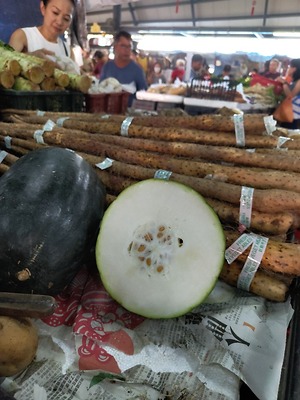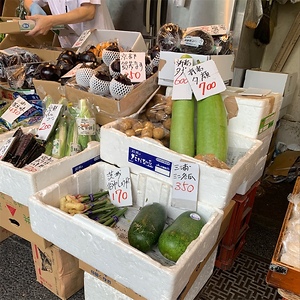


Tougan Melons
Estimated Inventory, lb : 0
Description/Taste
Tougan melons are large, averaging 15 to 80 centimeters in length and weighing up to 22 pounds, and have a bulbous, round, oval, to oblong shape with blunt, curved ends. The melons are covered in a thin but tough, light to dark green variegated skin, often enveloped in a textured, chalky layer of wax, depending on the variety. Young Tougan melons bear a pale, fuzzy coating of hair that disappears into the white bloom as the fruit matures. Underneath the hard surface, the flesh is thick, firm, white, and watery, encasing a sizeable central cavity filled with pithy membranes and cream-colored oval seeds. The seeds are edible once cooked and have a nutty, neutral taste. Tougan melons are typically cooked and contain a refreshing, mild, vegetal, and subtly grassy flavor reminiscent of cucumber. When cooked, the flesh softens, becoming transparent and absorbing accompanying flavors. In addition to the melons, the flowers, young shoots, and leaves are edible and are lightly cooked, contributing vegetal, clean flavors.
Seasons/Availability
Tougan melons are generally available in late summer through the fall, but the melons can be grown year-round in some warmer climates. The melon's unique waxy and hard exterior also allows it to be stored for extended periods, well into the winter season.
Current Facts
Tougan melons, botanically classified as Benincasa hispida, are an ancient, mild-flavored melon variety belonging to the Cucurbitaceae family. The large melons grow on sprawling vines that extend across the ground or climb on trellises and are native to Asia, where the melons have traditionally been utilized as a medicinal and culinary ingredient. Tougan melons are known by many names worldwide, including Winter melon, Wax gourd, Winter gourd, Ash gourd, Chinese Preserving Melon, Pethakaddu in Hindi, Dong Gua in Chinese, and Kundol in Tagalog. In Japan, Tougan translates to mean “winter melon,” and there are several types of Tougan melons, with the two most common being known as Daimaru and Naga Tougan melons. Daimaru melons translate from Japanese to mean “big and round,” and Naga translates to “long,” a descriptor of the melon’s shape. The melons also received their winter moniker from their extended storage capabilities. The fruit's surface is coated in a waxy layer, allowing the melon to be harvested in the fall and stored through the winter, providing a nutritious food source during the scarce winter months. Tougan melons are favored for their light, mild flavor and delicate, tender flesh when cooked, and in fresh markets throughout Asia, the melons are often sold pre-sliced due to their large size. Though they are botanically a fruit, Tougan melons are cooked and consumed similarly to vegetables, prevalent in soups, curries, stir-fries, and desserts.
Nutritional Value
Tougan melons are an excellent source of vitamin C to strengthen the immune system, potassium to balance fluid levels within the body, and fiber to stimulate and regulate the digestive tract. The melons also provide antioxidants to protect the body against environmental aggressors, magnesium to maintain healthy nerve functioning, phosphorus and calcium to promote strong bones and teeth, and contain lower amounts of folate, zinc, and iron. In eastern medicines, Tougan melons are viewed as having cooling properties and are consumed to reduce inflammation, remove excess moisture, and balance the body through alkaline properties.
Applications
Tougan melons have a mild, neutral flesh that readily absorbs accompanying flavors, well suited for cooked applications such as boiling, steaming, stir-frying, simmering, and braising. The melons can be served cold or hot and are versatile, incorporated into savory and sweet preparations. The melon’s waxy rind is inedible and is typically discarded, but sometimes the rind is hollowed and used as a decorative serving bowl. The seeds are also removed from the flesh before consumption, but they are edible once cooked and can be roasted or fried as a crunchy snack. Tougan melon flesh can be sliced or cubed into smaller pieces and incorporated into soups, especially miso, and into curries and stews. When simmered into broths, the melon develops a soft consistency and compliments the other ingredients in the dish by providing added texture. The flesh can also be incorporated into sushi, stir-fried with robust spices and herbs, stuffed with meat and cooked, mixed into casseroles, or quick-pickled, known as asazuke in Japan. Beyond savory preparations, Tougan melons can be cooked with sugar and used as a filling in cakes, pastries, and pies, simmered into a syrup or made into candy. During the autumn festival, Tougan melons are often used to flavor mooncakes. In Japan, Tougan melons are processed into a historical candy known as tougatsuke, cooked into many different soup types, and shredded into salads. In addition to the melon, the flowers, leaves, and young stems are edible and can be incorporated into soups, curries, and stews. Tougan melons pair well with mushrooms, bamboo shoots, cilantro, aromatics such as ginger, garlic, scallions, and onions, meats including pork, poultry, duck, and beef, seafood such as shrimp, crab, scallops, and fish, and citrus. Whole Tougan melons will keep for 3 to 5 months when stored in a cool, dark place away from direct sunlight. Once sliced, the melon pieces will keep up to one week when stored in a plastic bag in the refrigerator's crisper drawer. Peeled and raw Tougan melon chunks can also be frozen for extended use.
Ethnic/Cultural Info
In Japan, Tougan melons are cooked and served with white rice as an offering during the Tabanka Festival in the Shimotsuma Prefecture. The annual two-night festival is held in September at the Daiho Hachimangu Shrine and is an unusual tradition that remembers an evening in 1370 where Buddhist priests put out a fire at the temple with pot lids and tatami mats. During the festival, Tougan melons are a seasonal delicacy that is used as an offering to the Gods, presented in a celebratory performance before bonfires are lit throughout the shrine. The Tabanka Festival is also known as the Winter Melon Festival, Wax Gourd, or Tougan Festival and is a rare event, celebrated only at the Daiho Hachimangu Shrine, and has been practiced for over 600 years.
Geography/History
Tougan melons are native to Asia and Southeast Asia, where they have been cultivated since ancient times. The vining plants are believed by experts to have been used in culinary and medicinal preparations in China as early as 500 CE, and over time, the species was established as a common garden cultivar in Japan, Indonesia, and India sometime before the 5th century. In Japan, Tougan melons are mainly produced in the Okinawa, Aichi, and Okayama prefectures. Today Tougan melons are grown in warm climates worldwide and sold through local markets, specialty grocers, and Asian markets in the Americas, Australia, Asia, Africa, and Europe.
Recipe Ideas
Recipes that include Tougan Melons. One
| Okinawa Hai |
|
Tougan Soup |












